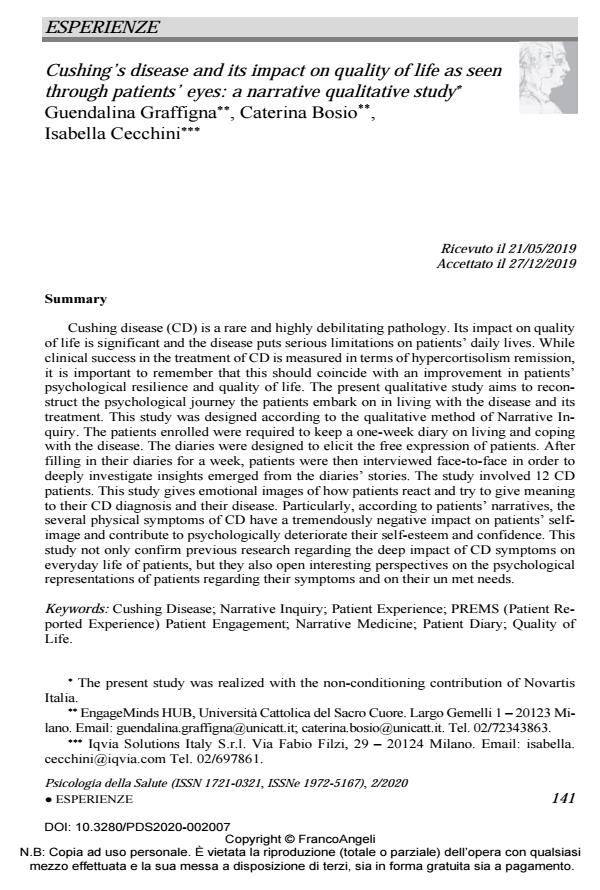Cushing’s disease and its impact on quality of life as seen through patients’ eyes: a narrative qualitative study
Journal title PSICOLOGIA DELLA SALUTE
Author/s Guendalina Graffigna, Caterina Bosio, Isabella Cecchini
Publishing Year 2020 Issue 2020/2
Language English Pages 17 P. 141-157 File size 527 KB
DOI 10.3280/PDS2020-002007
DOI is like a bar code for intellectual property: to have more infomation
click here
Below, you can see the article first page
If you want to buy this article in PDF format, you can do it, following the instructions to buy download credits

FrancoAngeli is member of Publishers International Linking Association, Inc (PILA), a not-for-profit association which run the CrossRef service enabling links to and from online scholarly content.
Cushing disease (CD) is a rare and highly debilitating pathology. Its impact on quality of life is significant and the disease puts serious limitations on patients’ daily lives. While clinical success in the treatment of CD is measured in terms of hypercortisolism remission, it is important to remember that this should coincide with an improvement in patients’ psy-chological resilience and quality of life. The present qualitative study aims to reconstruct the psychological journey the patients embark on in living with the disease and its treatment. This study was designed according to the qualitative method of Narrative Inquiry. The pa-tients enrolled were required to keep a one-week diary on living and coping with the dis-ease. The diaries were designed to elicit the free expression of patients. After filling in their diaries for a week, patients were then interviewed face-to-face in order to deeply investigate insights emerged from the diaries’ stories. The study involved 12 CD patients. This study gives emotional images of how patients react and try to give meaning to their CD diagnosis and their disease. Particularly, according to patients’ narratives, the several physical symp-toms of CD have a tremendously negative impact on patients’ self-image and contribute to psychologically deteriorate their self-esteem and confidence. This study not only confirm previous research regarding the deep impact of CD symptoms on everyday life of patients, but they also open interesting perspectives on the psychological representations of patients regarding their symptoms and on their un met needs.
Keywords: Cushing Disease; Narrative Inquiry; Patient Experience; PREMS (Patient Re-ported Experience) Patient Engagement; Narrative Medicine; Patient Diary; Quality of Life.
- “The healthcare system did fail me repeatedly”: a qualitative study on experiences of healthcare among Canadian women with Cushing’s syndrome Sarah C Jones, Sarah Nutter, Jessica F Saunders, in BMC Primary Care 329/2024
DOI: 10.1186/s12875-024-02580-5
Guendalina Graffigna, Caterina Bosio, Isabella Cecchini, Cushing’s disease and its impact on quality of life as seen through patients’ eyes: a narrative qualitative study in "PSICOLOGIA DELLA SALUTE" 2/2020, pp 141-157, DOI: 10.3280/PDS2020-002007